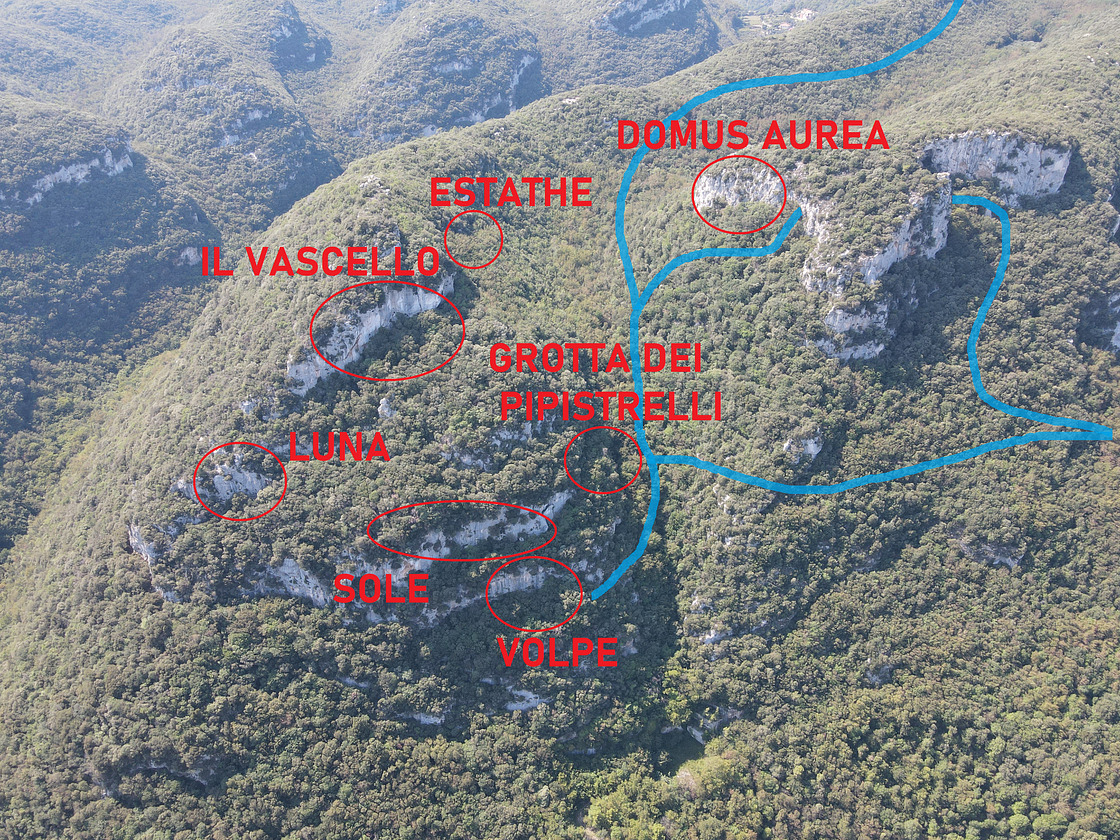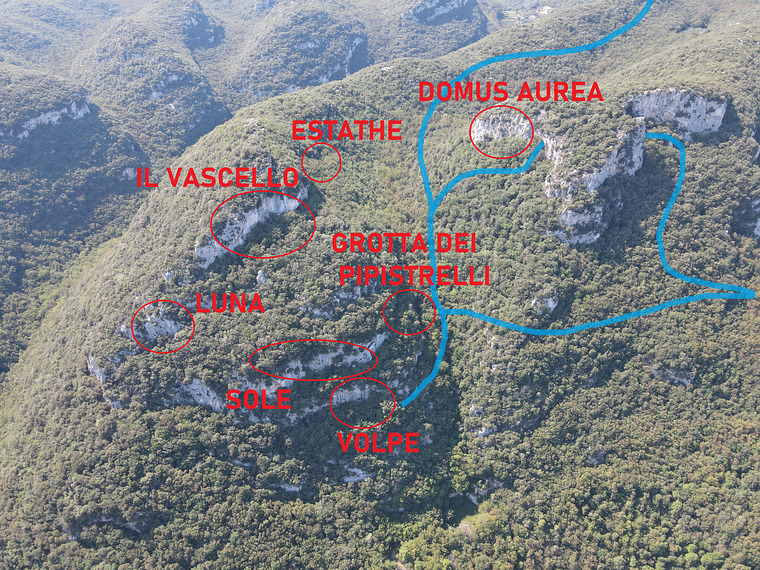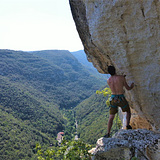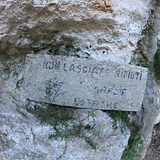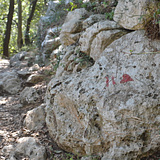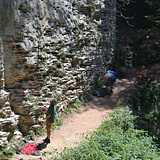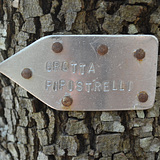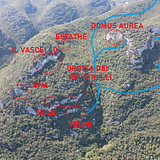⚠️Low phone signal, Download the topo before⚠️
☀️SUN DURING THE DAY:
•All Day : Domus Aurea
•Morning : Il Vascello, Falesia del Sole, Falesia della Luna, Falesia della Volpe
•Never: Grotta dei Pipistrelli, Estathè
🧭 EXPOSURE:
•N: Grotta dei Pipistrelli, Estathè
•S: Domus Aurea
•N-E: Il Vascello
•E: Falesia della Luna, Falesia del Sole, Falesia della Volpe
🧱ROCK TYPE: The rock here is Limestone.
📆 BEST PERIOD:
All the crags except Domus Aurea are ideal from April to November: 4-11
Domus Aurea: 10-4
👪 FAMILY FRIENDLY:
YES: Estathè, Il Vascello, Falesia della Luna, Falesia del Sole, Grotta dei Pipistrelli.
NO: Domus Aurea, Falesia della Volpe.
📱PHONE SIGNAL: NO
🇬🇧
⛰️The Val di Nava is nestled between Val Cornei and the Valle dei Boragni, creating a mysterious atmosphere that conceals splendid caves, where cracks and holes are ever-present. But that's not all – you'll also find walls with technical slabs, where routes reach up to 8b+ difficulty, as well as more accessible cliffs for those who are less experienced. These hidden cliffs, though concealed, can be reached through equally concealed paths. Thanks to 27crags' map section, you can even see the paths in real-time using GPS.
The rock of excellent quality becomes the perfect stage for climbing enthusiasts. Set against a backdrop of tranquility, the Val di Nava stands among the most serene valleys in Finale, offering an ideal experience especially during the warm summer days. In this valley, a bit of Finale's history, and beyond, has been written. Klem Loskot passed through this valley, leaving his mark as always, with routes of the highest difficulty. In this case, "Di più" at Estathè is a gem of history. If you're skilled at moving on 8b, try to emulate a legend like Klem Loskot by repeating his line.
-Grotta dei Pipistrelli: A cave hidden in vegetation; routes of medium-high difficulty, very bouldery.
-Falesia della Volpe: Short wall with routes accessible to everyone.
-Falesia del Sole: Another vertical wall with routes mainly in the 6th grade.
-Falesia della Luna: Another vertical wall with routes in the 5th and 6th grades.
-Il Vascello: A wall resembling the bow of a ship, from which the sector gets its name; routes of medium-high
difficulty on a white and gray wall.
-Estathè: Short and brief cave to the left of "Il Vascello"; pure strength is necessary.
🇮🇹
⛰️ La Val di Nava si trova incastonata tra la Val Cornei e la Valle dei Boragni, creando un'atmosfera misteriosa che cela splendide grotte, dove fessure e buchi si fanno onnipresenti. Ma non solo, troverai anche pareti con placche tecniche, dove le linee arrivano fino all'8b+, ma anche falesie più accessibili per chi è meno esperto. Queste falesie, seppur nascoste, sono raggiungibili attraverso sentieri altrettanto nascosti, ma grazie a 27crags nella sezione mappe si possono vedere i sentieri in tempo reale con il GPS.
La roccia di eccellente qualità diventa il perfetto palcoscenico per gli amanti dell'arrampicata. Immersa in uno scenario di tranquillità, la Val di Nava si annovera tra le valli più serene del Finalese, donando un'esperienza ideale soprattutto durante le calde giornate estive. In questa valle si è scritta un po' di storia finalese e non solo. Klem Loskot è passato furtivamente da questa valle lasciando il suo segno come sempre, con vie di altissima difficoltà. In questo caso, "Di più" all'Estathè è una perla di storia. Se siete in grado di muovervi bene sull'8b, provate ad emulare una leggenda come Klem Loskot, ripetendo la sua linea.
Domus Aurea: Settore soleggiato, conformazione spettacolare della roccia; settore molto strapiombante e settore placche.
-Grotta dei Pipistrelli: Una grotta nascosta nella vegetazione; vie di difficoltà medio-alta, molto boulderose.
-Falesia della Volpe: Corto muro con vie accessibili per tutti.
-Falesia del Sole: Un altro muro verticale con vie prevalentemente sul 6 grado.
-Falesia della Luna: Un altro muro verticale con vie sul 5 e 6 grado.
-Il Vascello: Un muro che ricorda la prua di un vascello, da cui deriva il nome del settore; vie di difficoltà medio-
alta su un muro bianco e grigio.
-Estathè: Antro corto e breve a sinistra del "Vascello"; la forza pura è necessaria.
🇩🇪
⛰️Das Val di Nava liegt eingebettet zwischen dem Val Cornei und dem Valle dei Boragni und schafft eine mysteriöse Atmosphäre, die wundervolle Höhlen verbirgt, in denen Spalten und Löcher allgegenwärtig sind. Aber das ist nicht alles - du wirst auch Wände mit technischen Platten finden, wo Routen bis zu einer Schwierigkeit von 8b+ reichen, sowie zugänglichere Klippen für diejenigen, die weniger erfahren sind. Diese versteckten Klippen, obwohl verborgen, sind über ebenso versteckte Pfade erreichbar. Dank des Kartenabschnitts von 27crags kannst du die Pfade sogar in Echtzeit mit GPS verfolgen.
Der Fels von ausgezeichneter Qualität wird zur perfekten Bühne für Kletterbegeisterte. Eingebettet in eine Kulisse der Ruhe gehört das Val di Nava zu den friedlichsten Tälern in Finale, und bietet besonders während der warmen Sommertage ein ideales Erlebnis. In diesem Tal wurde ein Stück der Geschichte von Finale und darüber hinaus geschrieben. Klem Loskot durchstreifte dieses Tal heimlich und hinterließ, wie immer, seine Spuren mit Routen von höchster Schwierigkeit. In diesem Fall ist "Di più" im Estathè ein Juwel der Geschichte. Wenn du gut auf 8b klettern kannst, versuche, eine Legende wie Klem Loskot zu emulieren, indem du seine Route wiederholst.
-Grotta dei Pipistrelli: Eine in der Vegetation verborgene Höhle; Routen von mittlerem bis hohem Schwierigkeitsgrad, sehr Boulder-geprägt.
-Falesia della Volpe: Kurze Wand mit für jeden zugänglichen Routen.
-Falesia del Sole: Eine weitere vertikale Wand mit hauptsächlich Routen im 6. Schwierigkeitsgrad.
-Falesia della Luna: Eine weitere vertikale Wand mit Routen im 5. und 6. Schwierigkeitsgrad.
-Il Vascello: Eine Wand, die den Bug eines Schiffs darstellt, von dem der Sektor seinen Namen hat; Routen von
mittlerem bis hohem Schwierigkeitsgrad an einer weißen und grauen Wand.
-Estathè: Kurze und kompakte Höhle links von "Il Vascello"; reine Stärke ist erforderlich.
